

 December 1, 1995
December 1, 1995Contained in the report is information for the use of all those interested in the State's finances, including South Carolina taxpayers, members of the General Assembly and directors of the State's executive agencies as well as those investors and creditors with whom the State has an ongoing business relationship.
As the Comptroller General and chief financial officer of South Carolina, I present these financial statements as my representations, and I express confidence that the information is accurate in all material respects. The citizens of South Carolina may be further assured that this report contains all material facts about the State's financial condition and thereby reflects my total commitment to accountability to the taxpayers through full public disclosure.
For the convenience of users, we have divided the report into three sections as follows:
The State allocated $195 million to provide homeowners with relief from property taxes for school operations—$117.5 million from 1995-96 appropriations and $77.5 million from 1994-95 surplus supplemental appropriations.. The relief measure, which will apply to 89% of all homes in South Carolina, provides that up to $100,000 of each home's assessed value will be exempt from the tax.
The State's steps to reduce the size of government included the application of a 5% across-the-board budget cut to most State agencies for 1995-96. This amounted to some $55 million. Exempted from the cut were appropriations for: (1) public schools, which received an additional $57.3 million of General Fund appropriations, including a 4.2% average salary increase for teachers, (2) higher education, which received a one-time appropriation of $53.2 million, and (3) the Department of Corrections, which received additional appropriations of $27.5 million, half of which is allocated to open a new prison. Despite these reductions, the State was able to provide State employee pay raises averaging 3.5%.
Other major legislative initiatives during the 1995 session were in the areas of crime and welfare reform. Criminal justice actions included adoption of a truth-in- sentencing measure designed to bring uniformity to the time an inmate serves before becoming eligible for work release or parole. The bill also addressed multiple offenses (provisions requiring life sentences for two or three convictions of certain offenses), expansion of the definition of "violent" crime, and the use of lethal injection for execution. Welfare reform legislation provided for initiatives which would limit eligibility for recipients, keep families intact, and discourage abuse of the system.
The State's tourism and retirement industries have also been rapidly growing economic sectors over the last two decades. Each year more retirees move here to take advantage of the area's mild climate, lower cost of living and special tax breaks for people over age 65. The number of individuals receiving Social Security retirement pay has grown at a rapid average annual rate of 4.5% since 1970. The annual income of retirees now exceeds an estimated $4 billion.
The State's coastal areas have emerged as one of the leading tourism centers on the east coast, providing even more stimulus to South Carolina's growing economy. Personal income in Horry County, which includes the Myrtle Beach area, has grown at an extraordinary 10.9% per year over the last two decades and now exceeds $2 billion.
Since 1970, nearly 400,000 people have migrated to the State to take advantage of a growing economy and to retire here. Total personal income of South Carolina has grown over eight-fold, one-fifth faster than growth in personal income in the United States. During the high inflationary 1970's personal income grew at an average annual compound rate of 11.8% compared to a lower 10.6% nationwide. Even in the lower inflationary 1980's personal income in South Carolina grew a healthy 8.4% per year, compared to a lesser 7.5% nationwide. Employment in South Carolina over the last two decades has grown one-fifth faster than in the United States as a whole.
Although South Carolina has been one of the poorer states in the nation since the War Between the States, the State is closing the gap in wealth between it and the rest of the country. In 1970, per capita income of South Carolina was only 74% of the national average but has since increased to 81% of the national average.
The State's economy has begun 1995-96 on a positive footing. Funds are available to help prevent budgetary reductions in the event of an economic slowdown during the fiscal year. Employment in the State was up by nearly 120,000 in August 1995 versus its level during the recession of 1991. Although statistics for the fiscal year were not yet available from the Department of Commerce, the State's Board of Economic Advisors estimated that personal income growth was in the healthy range of 5% to 6%.
Even though the Federal government will complete closure of the Charleston Naval Base at the end of 1995, the outlook for the near term is for continued growth in the State's total income in the 5% range or more. The new Bavarian Motor Works (BMW) automobile assembly plant in Spartanburg County and the Hoffman-La Roche pharmaceutical facility in Florence County have begun production. This year the State passed the Enterprise Zone Act of 1995 providing significant tax incentives for new and expanded businesses. Numerous companies already have applied for enterprise zone incentives, and there have been other announcements of new plants or additions to existing plants in the State which will contribute to the State's continued growth.
The State's Board of Economic Advisors originally estimated that the State's Budgetary General Fund revenues for 1995-96 would be $35.4 million less than the actual revenues for 1994-95. At the end of the first three months of 1995-96, however, Budgetary General Fund revenue collections were greater than anticipated. Accordingly, in November 1995 the Board of Economic Advisors increased its estimate of 1995-96 revenues by $43.2 million. The Income Tax and Sales Tax, the State's two leading sources of revenues, were both healthy, indicating that the State's economy was growing as expected.
An automated system in the Comptroller General's Office designed to allow reporting in accordance with generally accepted accounting principles (GAAP) converts budgetary-basis STARS data into the format presented in this report. State agencies that use STARS complete forms at year-end to adjust the budgetary-basis balances to conform with GAAP. The Comptroller General's Office enters data into the GAAP reporting system from these forms as well as from audited financial statements for the higher education institutions, component units, and most State enterprise entities.
The State's internal control structure provides reasonable, but not absolute, assurance that:
Budgetary Controls
South Carolina's annual Appropriation Act includes legally adopted budgets
for the Budgetary General Fund and for aggregated Other Budgeted Funds. Except
for the Retail Sales Tax and selected other taxes, which are estimated on a modified
accrual basis, the State estimates revenues on a cash receipts basis. Appropriations
for 1994-95 covered all expenditures deemed applicable to that year and paid on or
before July 20, 1995. Agencies may carry forward up to 10% of unexpended
Budgetary General Fund appropriations to the next year. Any remaining unexpended
Budgetary General Fund appropriations lapse unless the Appropriation Act
specifically authorizes agencies to carry them forward to the next fiscal year.
State law does not require encumbrance accounting. Accordingly, the State does not record encumbrances (except for some higher education institutions). The State currently maintains budgetary control for expenditures at the level of summary object category within each program of each organizational unit. Except for accounts of higher education institutions, STARS checks to be sure that an account has sufficient remaining appropriations before it will charge an expenditure to that account. Organizational units may request transfers of appropriations among object categories and/or among programs within the same budgetary fund. The Budget and Control Board has authority to approve these appropriation transfers within certain limits.
The initial budget appears in the annual Appropriation Act. The Budget and Control Board reduces the Budgetary General Fund's appropriations during the year if it anticipates a year-end operating deficit. Likewise, the State Board of Economic Advisors may approve revisions of estimated revenues of the Budgetary General Fund during the year. One such upward revision was approved in February 1995. During 1994-95, the General Assembly enacted a series of Joint Resolutions that added supplemental appropriations to the Budgetary General Fund for the fiscal year ended June 30, 1995. One of these resolutions appropriated $38.8 million from Budgetary Fund Balance at the end of 1993-94. Of the $38.8 million, $25.3 million was disbursed during the fiscal year ended June 30, 1995, while the remaining $13.5 million was reserved as Appropriations to be Carried Forward to 1995-96. The remaining resolutions set aside $237.6 million of Budgetary Fund Balance, of which $0.7 million was expended, $10.6 million was used to fund the General Reserve, and the remaining $226.3 million was appropriated and reserved as Appropriations to be Carried Forward to 1995-96.
State law specifies procedures for processing requested budget changes in Other Budgeted Funds and for permanent improvement projects.
Component units are legally separate entities for which the State and its elected officials are considered to be financially accountable. Criteria to determine financial accountability include the ability of State officials to appoint a voting majority of the entity's governing body, the ability of the State to impose its will on the entity, and the potential for the entity to provide a financial benefit to the State or impose a financial burden upon the State. The State's discretely presented component units are: the South Carolina Public Service Authority (Santee-Cooper); South Carolina State Ports Authority; the Savannah Lakes Regional Loan Fund; and Enterprise Development, Incorporated, of South Carolina. Note 1a in the Notes to the Financial Statements provides a more complete description of the State's reporting entity.
Revenues
The State's most significant sources of revenue are its 5% retail sales tax, its
individual income tax (2.50% to 7% tax rates) and Federal grants. The following
schedule summarizes revenues of the General and Special Revenue Funds for the
fiscal year ended June 30, 1995 (expressed in thousands) and the amounts (expressed
in thousands) and percentages of increases (decreases) in relation to prior year
revenues:
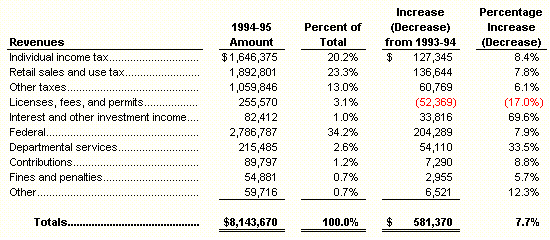

Interest and Other Investment Earnings were higher than the previous year because more cash was available to invest and interest rates were higher.
Part of the increase in Departmental Services revenues was due to an increase in Medicaid reimbursements. In addition, due to a change in State law, the State's Department of Transportation performed additional contractual services for county governments. The State recorded these additional revenues in the Departmental Services category.
The increase in Other Revenues is attributable to an increase in the amount of
matching funds for Federal grants provided by organizations outside State
government.
Expenditures
The following schedule presents a summary of General Fund and Special
Revenue Funds expenditures for the fiscal year ended June 30, 1995, (expressed in
thousands) and the amounts (expressed in thousands) and percentages of increases
(decreases) in relation to prior year expenditures:
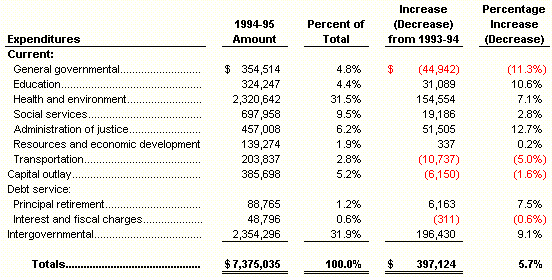
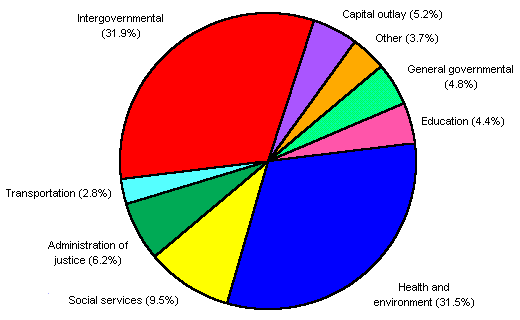
During 1994-95, the State used Capital Improvement Bond proceeds to purchase a large number of school buses and other vehicles to transport children. This resulted in a spending increase in the Education category for the year.
Administration of Justice expenditures increased in 1994-95 due to the addition of more than 600 new full-time-equivalent personnel positions and the opening of a new prison facility in Turbeville. In addition, preliminary preparations and hiring occurred for yet another new prison facility, the Ridgeland Institution, scheduled to open in 1995-96.
Status of Fund Balances
GAAP-basis fund balances for the General Fund and Special Revenue Funds
at June 30 (expressed in thousands) for the last five years were:
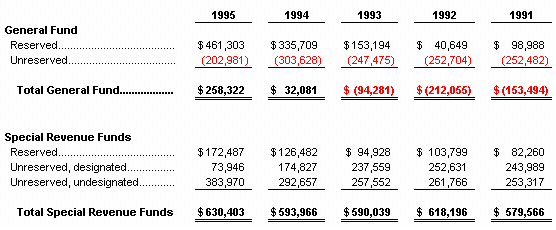
The designated portion of unreserved fund balance reflects tentative plans for future use of available financial resources.
Financial highlights of these segments (expressed in thousands) for the fiscal year ended June 30, 1995, are as follows:
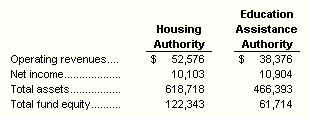
The Public Service Authority (Santee-Cooper) is South Carolina's State- owned public power resource. The Public Service Authority (Santee-Cooper) produces and sells electric power to individuals, businesses, electric cooperatives and municipal power departments. The Public Service Authority (Santee-Cooper) made payments to the State's General Fund of $6.2 million during its fiscal year ended December 31, 1994. The distribution to the General Fund is based primarily on operating cash flows and mandatory reserve requirements.
The State Ports Authority develops and maintains State harbors and seaports and handles the commerce through these ports.
Highlights of segment financial information (expressed in thousands) for discretely presented component units for the fiscal year ended June 30, 1995, are presented below:
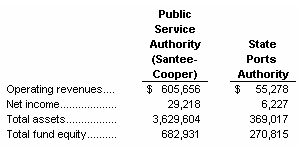

Moody's Investors Service has rated South Carolina's general obligation bonds as "Aaa," representing the highest rating awarded; Fitch Investors Service, Inc., rates these bonds as "AAA." For many years, Standard & Poor's also applied its top rating ("AAA") to these bonds. From March 1992 through January 1993, however, Standard & Poor's placed the State "on CreditWatch with negative implications." On January 29, 1993, Standard & Poor's lowered the State's rating on general obligation bonds to "AA+."
Standard & Poor's has stated that South Carolina must improve the structural balance between its revenues and expenditures and must address the GAAP accumulated deficit in the Budgetary General Fund in order to regain its former "AAA" rating. The fiscal year ended June 30, 1995, marked the third consecutive year in which the State made progress toward those goals. Specifically, after a moderate decrease in the GAAP deficit during 1992-93, the GAAP accumulated deficit was eliminated in 1993-94. At June 30, 1995, fund equity was $258.3 million. In addition, beginning in 1994-95, State law limits appropriations enacted in the annual general appropriations act to the lesser of:
The State's available legal debt margin at June 30, 1995, was $15.7 million for institution bonds. State law limits annual debt service expenditures rather than directly limiting the amount of outstanding debt for general obligation bonds/notes other than highway bonds, institution bonds, tax anticipation notes, and bond anticipation notes (if any). The annual debt service margin at June 30, 1995, for these bonds was $66.8 million.
Net general obligation bonds/notes outstanding per capita (which excludes general obligation bonds payable from Higher Education Funds) is a useful indicator to citizens, investors and management of the State's debt position. The following table shows these amounts at June 30 for the last three years:

The primary government's higher education institutions and enterprise entities had revenue bonds, notes, and certificates of participation of approximately $1.2 billion outstanding on June 30, 1995. Revenue bonds, notes, and certificates of participation outstanding (expressed in millions) by agency were:

In addition, discretely presented component units had the following amounts of bonds outstanding (expressed in millions) at June 30, 1995:

Legally authorized investments vary by fund, but generally include obligations of the United States and certain agencies of the United States, obligations of the State of South Carolina and certain of its political subdivisions, certificates of deposit, collateralized repurchase agreements and certain obligations of United States corporations. For additional details, see Note 1g in the Notes to the Financial Statements.
As provided by law, the State Treasurer deposits money in a general deposit account. The State records earnings of the general deposit account as revenue of the General Fund. The Treasurer deposits other monies into various special deposit accounts, each of which retains its own earnings.
State agencies that issue their own checks participate in pooled bank accounts. These agencies issue checks against the pooled bank accounts. Meanwhile, the State Treasurer invests account balances until the checks clear.
Investment earnings for the General Fund totaled $70.7 million for the fiscal year ended June 30, 1995.
The IRF services claims for many of the risks of loss to which the State is exposed, including the following: property insurance on governmentally owned buildings, the contents of such buildings, equipment, and automobiles; automobile liability insurance on governmentally owned vehicles and school buses; tort liability insurance for government premises and operations; and medical professional liability for hospitals. The IRF purchases insurance to cover risks where it has limited expertise (aircraft insurance and ocean marine insurance). The IRF purchases reinsurance to limit losses in the areas of property, boiler and machinery, automobile liability, and medical professional liability. Reinsurance permits partial recovery of losses from reinsurers; but the IRF, as direct insurer of the risks, remains primarily liable.
The Health and Disability Insurance Fund was established to provide health and dental insurance coverage for eligible employees and retirees of State agencies and school districts and group life and long term disability insurance coverage to eligible active State and public school employees. The State, the predominant participant, retains the risk of loss. Under the health insurance program, participants elect coverage through either a health maintenance organization or the State’s self- insured plan. All dental, group life, and long-term disability coverage is through the State’s self-insured plan.
Section 42-7-10 of the South Carolina Code of Laws, as amended, established the State Accident Fund to provide a program of workers' compensation insurance coverage to State entities. The State assumes the full risk for workers' compensation claims.
The State conducts various risk control programs to help minimize losses. For example, the health insurance program conducts extensive wellness education programs for covered employees that promote development and maintenance of healthful lifestyles.
The State also administers the Patients’ Compensation Fund, an insurance enterprise, which provides medical malpractice insurance.
The audit described above is not intended to meet the requirements of the Federal Single Audit Act of 1984. The Single Audit reports for the State are issued separately.
The State of South Carolina has received a Certificate of Achievement for the last seven consecutive years (1987-88 through 1993-94). Again this year, the State will submit its CAFR to the Certificate of Achievement for Excellence in Financial Reporting program of the GFOA. I firmly believe that South Carolina's report for the fiscal year ended June 30, 1995, meets the requirements to receive the Certificate of Achievement.
I would like to extend special thanks to South Carolina Wildlife magazine, a publication of the Department of Natural Resources, for providing photographs and captions for this report, to the SCANA Corporation for providing a photograph of the Lake Murray Dam and to Ron Chapiesky and Phillip Jones for their photography services. In addition, thanks are due to Dr. William C. Gillespie, Chief Economist of the State of South Carolina, and to Philip G. Grose, Jr., Director of the State Budget and Control Board's Executive Institute, who provided invaluable assistance in producing the report.
Sincerely,
EARLE E. MORRIS, JR.
Comptroller General
State of South Carolina